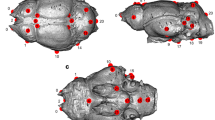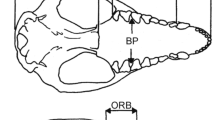Abstract
The Recognition Concept of Species is examined for its potential usefulness in discriminating speciation events in the hominid fossil record. Controversies over species-specific characteristics amongHomo erectus and archaicHomo sapiens have centred on traits of the skull, largely because this element is most commonly preserved. Modern humans have an intuitive knowledge of their own Specific Mate Recognition System (SMRS), and therefore have the opportunity to compare their own SMRS to that of fossil hominids and the extent pongids. Such comparison suggests that our own skeletal SMRS may depend less on features of the skull than on the morphology of the postcranial anatomy. We propose that these components be further examined in this regard. We tentatively conclude that examination of the Recognition Concept of Species indicates that from lateHomo erectus onwards, the same SMRS has been shared in common by all hominids, including modernHomo sapiens. This suggests that, following the SMRS criterion, none of these forms can be categorized as separate species.
Similar content being viewed by others
Bibliography
Andrews P., 1984.An alternative interpretation of characters used to define Homo erectus. Courier Forschungsinstitut Senckenberg 69: 167–175.
Benyon A.D. and Dean M.C., 1988.Distinct dental development patterns in early fossil hominids. Nature 335 509–514.
Buss D.M., 1989.Sex differences in human mate preferences: Evolutionary hypotheses tested in 37 cultures. Behavioral and Brain Sciences 12: 1–49.
Corrucini R.S., 1992.Metrical reconsideration of the Skhul IV and IX and Border Cave 1 crania in the context of modern human origins. American Journal of Physical Anthropology 87: 433–445.
Crawford C., 1989.Sex differences in life histories: the role of sexual selection in mate choice. Behavioral and Brain Sciences 12: 18.
Darwin C., 1895.The Origin of Species by Means of Natural Selection. John Murray, London.
Day M.H., 1971.Postcranial remains of Homo erectus from Bed IV, Olduvai Gorge, Tanzania. Nature, 232:383–387.
Day M.H., 1986.Guide to Fossil Man. University of Chicago Press, Chicago.
Day M.H., and Molleson T.I., 1973.The Trinil femora. In (M.H. Day ed.). Human Evolution, pp. 127–154, Taylor and Francis, London.
Feldesman M.R., Kleckner J.G., and Lundy J.K., 1990.Femur/stature ratio estimates of stature in Mid-and Late-Pleistocene fossil hominids. American Journal of Physical Anthropology, 83: 359–372.
Feldesman M.R., and Lundy J.K., 1988.Stature estimates for some African Plio-Pleistocene fossil hominids. Journal of Human Evolution, 17: 583–596.
Fontdevila A., 1988.The evolutionary potential of the unstable genome. In (Gerdina de Jong, ed.). Populations, Genetics and Evolution, pp. 61–72. Springer Verlag, Berlin.
Galdikas B.M.F. and Teleki G., 1981.Variations in subsistence activities of male and female pongids: new perspectives on the origins of human labor divisions. Current Anthropology 22: 241–256.
Harvey P.H., and Clutton-Brock T.H., 1985.Life history variation in primates. Evolution 39: 559–581.
Howells W.W., 1989.Skull Shapes and the Map: Craniometric Analysis in the Dispersion of Modern Humans. Papers of the Peabody Museum of Archaeology and Ethnology, Volume 79, Harvard University.
Howells W.W., 1980.Homo erectus—who, when and where: a survey, Yearbook of Physical Anthropology 23: 1–23.
Jungers W.L., 1988.Lucy's length: stature reconstructions in Australopithecus afarensis (A.L. 288-1) with implications for other small-bodied hominids. American Journal of Physical Anthropology, 76: 227–231.
Kennedy G.E., 1984.The emergence of Homo sapiens: the poscranial evidence. Man (New Series), 19: 94–110.
Kennedy K.A.R., 1989.Skeletal markers of occupational stress. In (M.Y. Iscan & K.A.R. Kennedy, eds.). Reconstruction of Life from the Skeleton, pp. 129–160. Alan R. Liss, New York.
King M., and Wilson A.C., 1975.Evolution at two levels in humans and chimpanzees. Science, 188: 107–116.
Lambert D.M., and Paterson H.E.H., 1982.Morphological resemblance and its relationship to genetic distance measures. Evolutionary Theory 5: 291–300.
Langridge J., 1991.Molecular Genetics and Comparative Evolution. John Wiley and Sons, Toronto.
Latimer B., and Lovejoy C.O., 1989.The calcaneous of Australopithecus afarensis and its implications for the evolution of bipedality. American Journal of Physical Anthropology, 78: 369–386.
Latimer B., and Lovejoy C.O., 1990.Metatarsophalangeal joints of Australopithecus afarensis. American Journal of Physical Anthropology, 83: 13–23.
Mayr E., 1970.Populations, Species, and Evolution. Harvard University Press, Boston.
McGrew W.C., 1979.Evolutionary implication of sex differences in chimpanzee predation and tool use. In (D.A. Hamburg and E.R. McCown, eds.). The Great Apes, Beniamin-Cummings, Menlo Park, California.
McHenry H.M., 1974.How large were the australopithecines? American Journal of Physical Anthropology, 40: 329–340.
McHenry H.M., 1991.Femoral lengths and stature in Plio-Pleistocene hominids. American Journal of Physical Anthropology, 85: 149–158.
Morris D., 1977.Manwatching, a Field Guide to Human Behaviour. Abrams Press, New York.
Paterson H.E.H., 1976. Symposium Address, 15th International Congress of Entomology. Washington, D.C.
Paterson H.E.H., 1980.A comment on the “mate recognition systems”. Evolution 34 (2): 330–331.
Paterson H.E.H., 1981.The continuing search for the unknown and unknowable: a critique of contemporary ideas of speciation. South African Journal of Science 77: 113–119.
Paterson H.E.H., 1982.Perspective on speciation by reinforcement. South African Journal of Science 78: 53–57.
Paterson H.E.H., 1985.The recognition concept of species. In (E. Vrba ed.). Species and Speciation, pp. 21–29. Transvaal Muscum Monograph No. 4, Pretoria.
Paterson H.E.H., 1986.Environment and species. South African Journal of Science 82: 62–65.
Phillips-Conroy J.E. and Jolly, C.J., 1986.Changes in the structure of the baboon hybrid zone in Awash National Park, Ethiopia. American Journal of Physical Anthropology 71: 337–350.
Rightmire G.P., 1986.Body size and encephalization in Homo erectus. In (V.V. Novotny & A. Mizerova). Fossil Man: New Facts and New Ideas. Anthropos (Brno) 23: 139–150.
Rightmire G.P., 1990.The Evolution of Homo erectus: Comparative Anatomical Studies of an Extinct Human Species. Cambridge University Press, Cambridge.
Ruff C.B., Trinkaus E., Walker A., and Larsen C.S., 1993.Postcranial robusticity in Homo. I: temporal trends and mechanical interpretation. American Journal of Physical Anthropology, 91: 21–53.
Smith B.H., 1986.Dental development in australopithecines and early Homo. Nature 323: 327–330.
Smith B.H., 1989.Dental development as a measure of life history in primates. Evolution 43: 683–688.
Smith F., Falsetti A., and Donnelly S., 1989.Modern human origins. Yearbook of Physical Anthropology 32: 35–68.
Stringer C.B., 1984.The definition of Homo erectus and the existence of species in Africa and Europe. Courier Froschungsinstitut Senckenberg 69: 131–143.
Stringer C.B., Hublin J.J., and Vandermeersch B., 1984.The origin of anatomically modern humans in western Europe. In (F.H. Smith and F. Spencer, eds.). The Origin of Modern Humans: A World Survey of the Fossil Evidence, pp. 51–135. Alan R. Liss, New York.
Susman R.L., Stern Jr., J.T. and Jungers W.L., 1985.Locomotor adaptations in the Hadar hominids. In (E. Delson ed.). Ancestors: The Hard Evidence, pp. 184–192. Alan R. Liss, New York.
Symons D., 1979.The Evolution of Human Sexuality. Oxford University Press, Oxford.
Tattersall I., 1986.Species recognition in human paleontology. Journal of Human Evolution 15: 165–175.
Trinkaus E., 1983.Neandertal postcrania and the adaptive shift to modern humans. In (E. Trinkaus, ed.). The Mousterian Legacy: Human Biocultural Change in the Upper Pleistocene, pp. 165–200. British Archaeological Report Series 164.
Trivers R., 1985.Social Evolution. Benjamin/Cummings, California.
Turner A., 1985.The recognition concept of species in paleontology, with special consideration of some issues in hominid evolution. In (E. Vrba, ed.) Species and Speciation, pp. 153–158. Transvaal Museum Monograph No. 4, Pretoria.
Turner A., 1986.Species, speciation and human evolution. Human Evolution 1 (5): 419–430.
Turner A. and Chamberlain A., 1989.Speciation, morphological change and the status of African Homo erectus. Journal of Human Evolution 18: 115–130.
Vandermeersch B., 1985.The origin of the Neanderthals. In (E. Delson, ed.). Ancestors the Hard Evidence, pp. 306–309. Alan R. Liss, New York.
Vrba E., 1980.Evolution, species, and fossils: how does life evolve? South African Journal of Science 76: 61–84.
Wood, B.A., 1984.The origin of Homo erectus. Courier Forschungsinstitut Senckenberg 69: 99–111.
Author information
Authors and Affiliations
Rights and permissions
About this article
Cite this article
Galdikas, B.M.F., Duffy, J.B., Odwak, H. et al. Postcrania and the specific mate recognition system. Hum. Evol. 8, 281–289 (1993). https://doi.org/10.1007/BF02438118
Received:
Accepted:
Issue Date:
DOI: https://doi.org/10.1007/BF02438118




